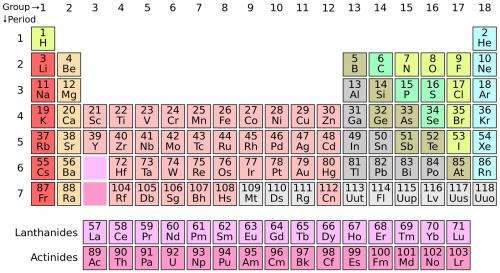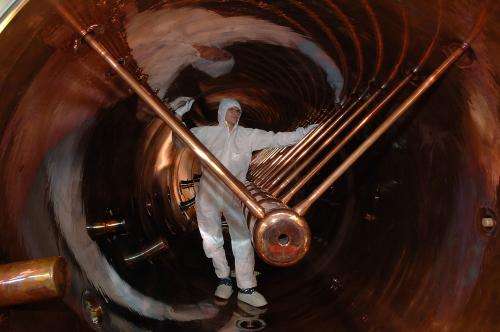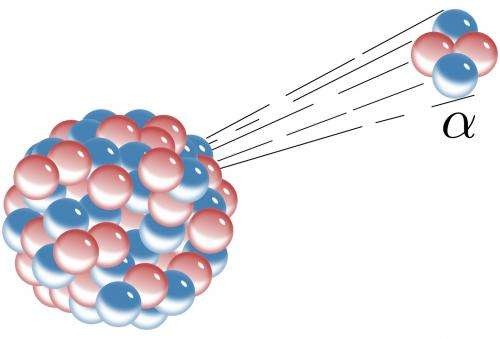Modern-day alchemy: A recipe for a new superheavy element

Even though nearly 80 years have passed since the discovery of Technetium, the first "synthetic" element, the periodic table of elements remains a work in progress.
On Tuesday, evidence for the existence of element 115—a potential new addition to the periodic table – was published in The Physical Review Letters.
The element has 115 protons, only lives for fractions of a second on average, and is one of several that may eventually be considered for entry into the exclusive chemical club.
To see what it takes to add a new element to the periodic table (below)—and to understand why seeking to make these new elements is important—we first need to understand what scientists are trying to create.
An island of stability
Element 115 is a "superheavy" element—only one of a cluster of synthetic elements with atomic numbers greater than 104. Including all the isotopes of each superheavy element, this cluster forms an "island of stability" at the very top end of the nuclear chart.
As the name suggests, the occupants of this island are heavy, weighing around 20% more than the largest naturally occurring element, Uranium. But they are also special in another way: they only exist because of a rather important quantum mechanical feature of the subatomic world.
In this world, some numbers of protons and neutrons are special—so special, in fact, that they're called "magic numbers". Nuclei with magic numbers of protons or neutrons (or sometimes both) are more stable than their neighbours, meaning that they live longer on average than the nuclei that surround them on the nuclear chart.
At the centre of the island of stability, two magic numbers intersect. These magic numbers make the quest for superheavy elements possible.
Smash and crash
Creating new elements is not a simple process. Scientists use a particle accelerator to smash light atoms into a thin metallic foil that contains heavier atoms, in the hope that the two nuclei at the centre of these atoms will come together, or fuse, forming a heavier element. This sounds like a rather brutal process, and it is, except for one thing: atoms are mostly empty space.

If an atom were blown up to the size of the Melbourne Cricket Ground, the atomic nucleus at its centre would be the size of a small grape. To create a new element, the tiny nuclei at the centre of both atoms must be close enough to touch. Only then can the nuclear force—the strong force that glues the protons and neutrons in the atomic nucleus together—begin to act.
There are two things working against us:
1. Atomic nuclei are positively charged. Like charges repel each other, so the accelerated nucleus has to have enough energy to overcome this repulsive force, but not so much energy that the two colliding nuclei will quickly tear themselves apart again.
2. Even if the nuclei are close enough to touch, the chance that those two nuclei properly fuse into a new element is very small—so small, in fact, that we may only have one or two superheavy elements to show for several weeks of continuous effort.
The rest of the time, the atomic collisions result in many other outcomes, such as other elements, all of which have to be separated somehow from the elements we are interested in creating.
A drop in the sea
For the latest work on element 115, a powerful device called TransActinide Separator and Chemistry Apparatus (TASCA) was used to roughly separate out the element of interest (along with other products with similar mass and charge) from the rest of the products of the atomic collision. TASCA is a gas-filled separator—one of several used for superheavy and heavy element studies in the world—that exploits the fact that particles with different masses and charges take separate paths through a magnetic field.
But a gas-filled separator is not enough to uniquely separate out and identify a new element. Other ways of detecting and identifying the presence of a new superheavy element must be used, in order to make a strong case that the element does indeed exist.
Here is where the problem gets tricky. How do you identify a short-lived element you know nothing about, particularly when you only have an atom at a time to work with?
For the case of superheavy elements, there is no single perfect answer to this question. Scientists typically use a wide range of clues to identify the elements created. Some of these clues originate from the atomic properties of the element—in other words, from the electron cloud surrounding the atomic nucleus. Others originate from the atomic nucleus, and may be different for different isotopes of a given element.
To identify new superheavy elements, scientists often begin by looking for characteristic decay patterns that lead us back to familiar territory—in other words, nuclei we already know a lot about. Because superheavy nuclei are not very stable, they tend to decay after a short period of time by emitting an alpha particle, or helium nucleus.
After each alpha decay, a new nucleus—lighter than its parent by two protons and two neutrons—is created. This new nucleus may also decay by emitting another alpha particle, and so on, until one of the daughter nuclei in the chain simply breaks into two by a process known as spontaneous fission.
Throughout this process, each atom may also emit other types of radiation resulting from the intricate factors influencing how each atomic nucleus decays. With the right detectors in place, all of these additional radiation signatures can be used to make a case for the existence of a new element.

Joining the club
The discovery of a new element, then, is often indirect. This is why new elements often have to wait a long time before they are officially added to the periodic table.
To be added to the periodic table, an independent committee of scientists from the international unions of Pure and Applied Chemistry (IUPAC) and Physics (IUPAP) carefully weigh all evidence supporting each element's existence and decide whether that evidence is strong enough to warrant a new entry in the periodic table. In most cases, elements that have been detected independently at more than one laboratory, ideally through more than one method, have a reasonable chance of making it into the table.
For element 115, a joint Russian-US collaboration first discovered signs of the element's existence at the Joint Institute for Nuclear Research (JINR) in Russia in 2004.
The more recent work, which was conducted at the GSI Helmholtz Centre for Heavy Ion Research in Germany, will play an important role in strengthening the element's case. Crucially, the new findings reveal both atomic and nuclear signatures that strongly support the element's existence.

A case for big science
At this point, you may be asking this: why create these new elements? The experiments are incredibly difficult, and even though new elements are discovered, they only live for a short time and have no immediate, obvious use.
The most direct answer is it is predicted that some of these as yet undiscovered superheavy elements will live longer than their current counterparts, and may even have applications that we have not yet dreamt of.
But the benefit of big science like this goes beyond direct impacts. By continuously reaching towards the edge of our knowledge, we often have to completely change how we think.
And there is something more difficult to define, too: the sense of collective wonder plainly reflected in the headlines announcing each new element. The fact that science has not yet completed something so iconic, so seemingly permanent, as the periodic table of elements is enough to remind all of us that we still have a great deal to learn about our universe.
Journal information: Physical Review Letters
Source: The Conversation
This story is published courtesy of The Conversation (under Creative Commons-Attribution/No derivatives).
![]()





















